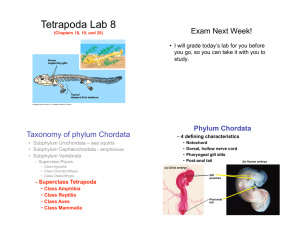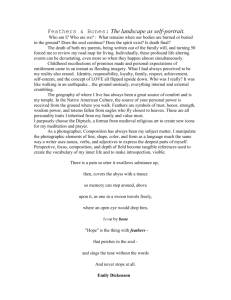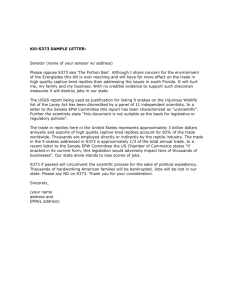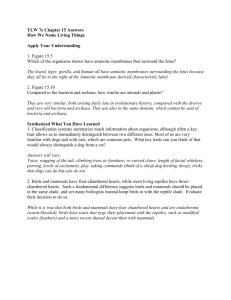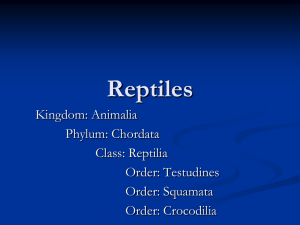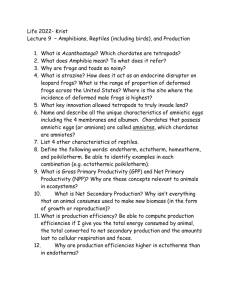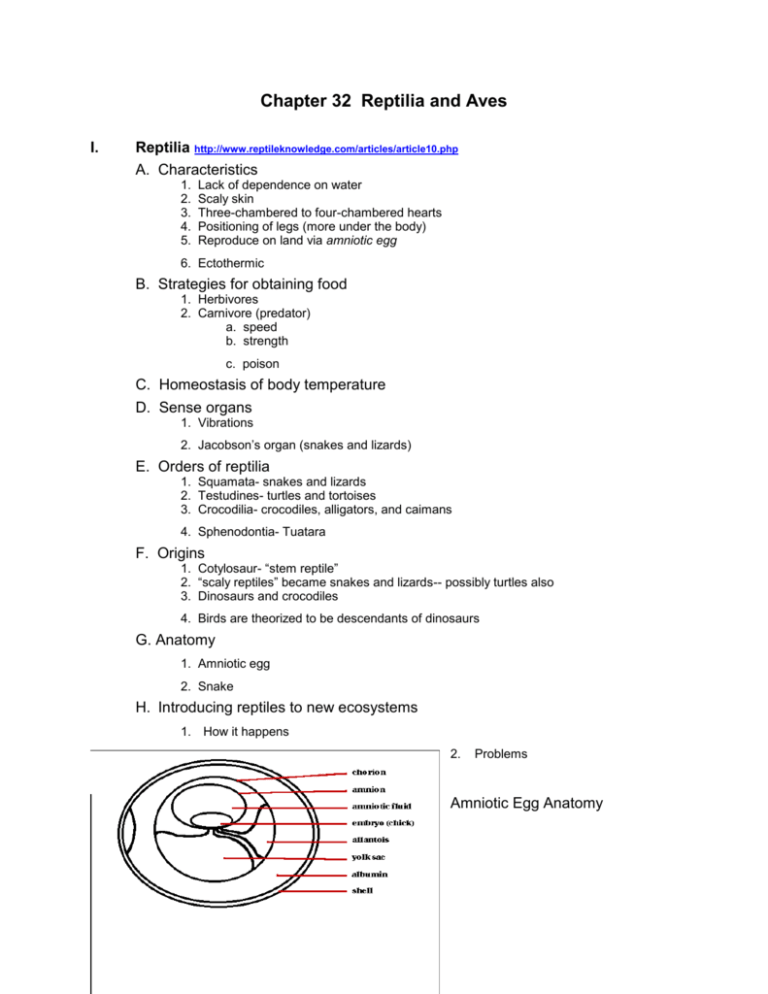
Chapter 32 Reptilia and Aves
I.
Reptilia http://www.reptileknowledge.com/articles/article10.php
A. Characteristics
1.
2.
3.
4.
5.
Lack of dependence on water
Scaly skin
Three-chambered to four-chambered hearts
Positioning of legs (more under the body)
Reproduce on land via amniotic egg
6. Ectothermic
B. Strategies for obtaining food
1. Herbivores
2. Carnivore (predator)
a. speed
b. strength
c. poison
C. Homeostasis of body temperature
D. Sense organs
1. Vibrations
2. Jacobson’s organ (snakes and lizards)
E. Orders of reptilia
1. Squamata- snakes and lizards
2. Testudines- turtles and tortoises
3. Crocodilia- crocodiles, alligators, and caimans
4. Sphenodontia- Tuatara
F. Origins
1. Cotylosaur- “stem reptile”
2. “scaly reptiles” became snakes and lizards-- possibly turtles also
3. Dinosaurs and crocodiles
4. Birds are theorized to be descendants of dinosaurs
G. Anatomy
1. Amniotic egg
2. Snake
H. Introducing reptiles to new ecosystems
1. How it happens
2.
Problems
Amniotic Egg Anatomy
Snake Anatomy
Jacobson’s Organ
Fang
"Generalized Anatomy of a Snake," Microsoft(R) Encarta(R) 96 Encyclopedia. (c) 1993-1995 Microsoft Corporation. All rights reserved.II.
Aves
A. Characteristics
1. Clawed toes (like reptiles)
2. Scaled feet
“
“
3. Internal fertilization and amniotic eggs
4. Modified scales called feathers- similar to reptile DNA
5. Modified frontal area for flight
6. Endothermic
7. 4 chambered heart
B. Origins
1.
2.
3.
4.
Thought to have descended from small, two-legged dinosaurs (thecodontia)
DNA of feathers is over 90% similar to reptile scales DNA
Pelvic girdle similar to dinosaurs
Development of endothermy like mammals
C. Adaptations
1.
2.
3.
4.
Beaks- what is the bird’s food source?
Wings- what is the bird’s environment, niche?
Egg size
Adaptations for flight
D. Types of feathers
1. Contour
2. Down
3. Powder
E. Orders of aves
1. 27-30 orders of aves have been created http://animals.about.com/od/birds/p/aves.htm
2. About 8600 species
Vocabulary:
amniotic egg:
endothermic:
feathers:
Jacobson’s organ:
niche:
scales:
sternum:
Study Questions
1. Discuss what is an amniotic egg and what are its evolutionary advancements.
2. As a biologist you are sent two species of birds to compare. After counting the
number of down and contour feathers on each bird (see chart) what would you
hypothesize as to their type of environments in which they live?
Contour feathers
Down feathers
# of feathers
species 1
species 2
3. What characteristics allow reptiles to be more active than amphibians?
4. Some snakes are able to eat prey much larger than themselves. Discuss this
adaptation and its advantages.
5. Discuss the three different types of feathers on birds.
6. Explain the theories of the origins of birds. How do you feel they may have come to
be (back up any conclusions/hypotheses with evidence).
7. One day a farmer comes to you with a question pertaining to biology. In the past
four years he has noticed that the owl population has dropped to about half and can’t
understand why. He asks you if he has done anything that might have scared them off.
Five years ago there was a rodent explosion. Everywhere the farmer went there were
rodents and lots of snakes. The owls that live in his area had lots of offspring and life
seemed to be alive more than ever. What would be your response to the farmer?
8. No snakes live on the Hawaiian Islands. How would the introduction of snakes there
affect the native wildlife? There are a couple recent examples of this problem, where
did they occur and what happened? Is this close to what you think would happen in
Hawaii?
9. Compare and contrast how reptiles and birds maintain homeostasis for body
temperature. Which is better and why.
10. Create your own dinosaur, including what it looks like, its scientific name, habitat,
and time period in which it lived. Be as creative as you possibly can: ie use computer
graphics, build a model, write a story, etc.

